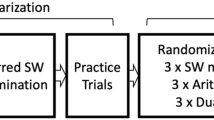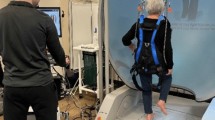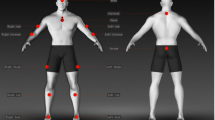Abstract
Low back pain (LBP) is often accompanied by changes in gait, such as a decreased (preferred) walking velocity. Previous studies have shown that LBP diminishes the normal velocity-induced transverse counter-rotation between thorax and pelvis, and that it globally affects mean erector spinae (ES) activity. The exact nature and causation of these effects, however, are not well understood. The aim of the present study was to examine in detail the effect of walking velocity on global trunk coordination and ES activity as well as their variability to gain further insights into the effects of non-specific LBP on gait. The study included 19 individuals with non-specific LBP and 14 healthy controls. Gait kinematics and ES activity were recorded during treadmill walking at (1) a self-selected (comfortable) velocity, and (2) sequentially increased velocities from 1.4 up to maximally 7.0 km/h. Pain intensity, fear of movement and disability were measured before the experiment. The angular movements of thorax, lumbar and pelvis were recorded in three dimensions. ES activity was recorded with pairs of surface electrodes. Trunk–pelvis coordination and mean amplitude of ES activity were analyzed. In addition, invariant and variant properties of trunk kinematics and ES activity were studied using principal component analysis (PCA). Comfortable walking velocity was significantly lower in the LBP participants. In the transverse plane, the normal velocity-induced change in pelvis–thorax coordination from more in-phase to more antiphase was diminished in the LBP participants, while lumbar and pelvis rotations were more in-phase compared to the control group. In the frontal plane, intersegmental timing was more variable in the LBP than in the control participants, with additional irregular movements of the thorax. Rotational amplitudes were not significantly different between the LBP and control participants. In the LBP participants, the pattern of ES activity was affected in terms of increased (residual) variability, timing deficits, amplitude modifications and frequency changes. The gait of the LBP participants was characterized by a more rigid and less variable kinematic coordination in the transverse plane, and a less tight and more variable coordination in the frontal plane, accompanied by poorly coordinated activity of the lumbar ES. Pain intensity, fear of movement and disability were all unrelated to the observed changes in coordination, suggesting that the observed changes in trunk coordination and ES activity were a direct consequence of LBP per se. Clinically, the results imply that conservative therapy should consider gait training as well as exercises aimed at improving both intersegmental and muscle coordination.







Similar content being viewed by others
References
Ahern DK, Follick MJ, Council JR, Laser-Wolson N, Litchman H (1988) Comparison of chronic low back pain patients and non-patient controls. Pain 34:153–160
Alexander KM, LaPier TL (1998) Differences in static balance and weight distribution between normal subjects and subjects with chronic unilateral low back pain. J Orthop Sports Phys Ther 28:378–383
Arendt-Nielsen L, Graven-Nielsen T, Svarrer H, Svensson P (1996) The influence of low back pain on muscle activity and coordination during gait: a clinical and experimental study. Pain 64:231–240
Batschelet E (1981) Circular statistics in biology. Academic, London
Brumagne S, Cordo P, Lysens R, Verschueren S, Swinnen S (2000) The role of paraspinal muscle spindles in lumbosacral position sense in individuals with and without low back pain. Spine 25:989–994
Callaghan JP, Patla AE, McGill SM (1999) Low back three-dimensional joint forces, kinematics, and kinetics during walking. Clin Biomech 14:203–216
Cohen J (1988) Statistical power analysis for the behavioral sciences, 2nd edn. Lawrence Earlbaum Associates, Hillsdale, NJ
Collins JJ, De Luca CJ (1994) Random walking during quiet standing. Phys Rev Lett 73:764–767
Crosbie J, Vachalathiti R, Smith R (1997) Age, gender and speed effects on spinal kinematics during walking. Gait Posture 5:13–20
Daffertshofer A, Lamoth CJC, Meijer OG, Beek PJ (2004) PCA in studying coordination and variability: a tutorial. Clin Biomech 19:415–428
Dingwell JB, Ulbrecht JS, Boch J, Becker MB, O’Gorman JT, Cavanagh PR (1999) Neuropathic gait shows only trends towards increased variability of sagittal plane kinematics during treadmill locomotion. Gait Posture 10:21–29
Fordyce WE (1976) Behavioral methods in chronic pain and illness. Mosby, St Louis
Gabor D (1946) Theory of communication. IEE J Commun Eng 93:429–457
Giakas G, Baltzopoulos V (1997) Time and frequency domain analysis of ground reaction forces during walking: an investigation of variability and symmetry. Gait Posture 5:189–197
Gill KP, Callaghan MJ (1998) The measurement of lumbar proprioception in individuals with and without low back pain. Spine 23:371–377
Grabiner MD, Koh TJ, el Ghazawi A (1992) Decoupling of bilateral paraspinal excitation in subjects with low back pain. Spine 17:1219–1223
Hausdorff JM, Mitchell SL, Firtion R, Peng CK, Cudkowicz ME, Wei JY, Goldberger AL (1997) Altered fractal dynamics of gait: reduced stride-interval correlations with aging and Huntington’s disease. J Appl Physiol 82:262–269
Hodges PW (2001) Changes in motor planning of feedforward postural responses of the trunk muscles in low back pain. Exp Brain Res 141:261–266
Hodges PW, Richardson CA (1999) Altered trunk muscle recruitment in people with low back pain with upper limb movement at different speeds. Arch Phys Med Rehabil 80:1005–1012
Hubley-Kozey CL, Vezina MJ (2002) Differentiating temporal electromyographic waveforms between those with chronic low back pain and healthy controls. Clin Biomech 17:621–629
Janda V (1978) Muscles, central nervous motor regulation and back problems. In: Korr IM (ed) The neurobiologic mechanisms in manipulative therapy. Plenum, New York, pp 27–41
Judge JO, Ounpuu S, Davis RB (1996) Effects of age on the biomechanics and physiology of gait. Clin Geriatr Med 12:659–678
Keefe FJ, Hill RW (1985) An objective approach to quantifying pain behavior and gait patterns in low back pain patients. Pain 12:153–161
Khodadadeh S, Eisenstein SM, Summers B, Patrick J (1988) Gait asymmetry in patients with chronic low back pain. Neuroorthopedics 6:24–27
Lamoth CJC, Beek PJ, Meijer OG (2002) Pelvis-thorax coordination in the transverse plane during gait. Gait Posture 16:101–114
Lamoth CJC, Daffertshofer A, Meijer OG, Moseley GL, Wuisman PIJM, Beek PJ (2004) Effects of experimentally induced pain and fear of pain on trunk coordination and back muscle activity during walking. Clin Biomech 19:551–563
Lamoth CJC, Meijer OG, Wuisman PIJM, van Dieën J, Levin MF, Beek PJ (2002) Pelvis–thorax coordination in the transverse plane during walking in persons with nonspecific low back pain. Spine 27:E92–E99
Lee J, Hoshino Y, Nakamura k, Kariya Y, Saita K, Ito K (1999) Trunk muscle weakness as a risk factor for low back pain. Spine 24:54–57
Lund JP, Donga R, Widmer CG, Stohler CS (1991) The pain-adaptation model: a discussion of the relationship between chronic musculoskeletal pain and motor activity. Can J Physiol Pharmacol 69:683–694
Luoto S, Aalto H, Taimela S, Hurri H, Pyykko I, Alaranta H (1998) One-footed and externally disturbed two-footed postural control in patients with chronic low back pain and healthy control subjects. A controlled study with follow-up. Spine 23:2081–2090
Magnusson ML, Aleksiev AR, Wilder DG, Pope MH, Spratt KF, Lee SH, Goel VK, Weinstein JN (1996) Unexpected load and asymmetric posture as etiologic factors in low back pain. Eur Spine J 5:23–25
Main CJ, Watson PJ (1996) Guarded movements: development of chronicity. J Musculoskel Pain 4:163–170
Maki BE (1997) Gait changes in older adults: predictors of falls or indicators of fear. J Am Geriatr Soc 45:313–320
McGibbon CA, Krebs DE (2001) Age-related changes in lower trunk coordination and energy transfer during gait. J Neurophysiol 85:1923–1931
Mientjes MI, Frank JS (1999) Balance in chronic low back pain patients compared to healthy people under various conditions in upright standing. Clin Biomech 14:710–716
O’Sullivan P, Twomey L, Allison G (1998) Altered abdominal muscle recruitment in low back pain patients following specific exercise intervention. J Orthop Sports Phys Ther 27:114–124
Panjabi MM (1992) The stabilizing system of the spine. Part I: Function, dysfunction and enhancement. J Spinal Disord 5:383–389
Panjabi MM (1992) The stabilizing system of the spine. Part II: Neutral zone and instability hypothesis. J Spinal Disord 5:390–397
Parkhurst TM, Burnett CN (1994) Injury and proprioception in the lower back. J Orthop Sports Phys Ther 19:282–295
Pijnappels M, Bobbert MF, van Dieën JH (2001) Changes in walking pattern caused by the possibility of a tripping reaction. Gait Posture 14:11–18
Porges SW, Bohrer RE, Cheung MN, Drasgow F, McCabe PM, Keren G (1980) New time-series statistic for detecting rhythmic co-occurrence in the frequency domain: the weighted coherence and its application to psychophysiological research. Psychol Bull 88:580–587
Radebold A, Cholewicki J, Panjabi MM, Patel TC (2000) Muscle response pattern to sudden trunk loading in healthy individuals and in patients with chronic low back pain. Spine 25:947–954
Riley MA, Turvey MT (2002) Variability of determinism in motor behavior. J Mot Behav 34:99–125
Roland M, Morris R (1983) A study of the natural history of back pain. Part I: Development of a reliable and sensitive measure of disability in low back pain. Spine 8:141–144
Schache AG, Blanch PD, Rath DA, Wrigley TV, Starr R, Bennell KL (2001) A comparison of overground and treadmill running for measuring the three-dimensional kinematics of the lumbo-pelvic-hip complex. Clin Biomech 16:667–680
Selles RW, Wagenaar RC, Smit TH, Wuisman PIJM (2001) Disorders in trunk rotation during walking in patients with low back pain: a dynamical systems approach. Clin Biomech 16:175–181
Spenkelink CD, Hutten MM, Hermens HJ, Greitemann BO (2002) Assessment of activities of daily living with an ambulatory monitoring system: a comparative study in patients with chronic low back pain and nonsymptomatic controls. Clin Rehabil 16:16–26
Stokes VP, Andersson CA, Forssberg H (1989) Rotational and translational movement features of the pelvis and thorax during adult human locomotion. J Biomech 22:43–50
Taimela S, Kujala UM (1992) Reaction times with reference to musculoskeletal complaints in adolescence. Percept Mot Skills 75:1075–1082
Taylor NF, Evans OM, Goldie PA (2003) The effect of walking faster on people with acute low back pain. Eur Spine J 12:166–172
Thomas LK, Hislop HJ, Waters RL (1980) Physiological work performance in chronic low back disability: effects of a progressive activity program. Phys Ther 60:407–411
Thorstensson A, Roberthson H (1987) Adaptations to changing speed in human locomotion: speed of transition between walking and running. Acta Physiol Scand 131:211–214
van Dieën JH, Selen LP, Cholewicki J (2003) Trunk muscle activation in low-back pain patients, an analysis of the literature. J Electromyogr Kinesiol 13:333–351
van Emmerik REA, Wagenaar RC (1996) Effects of walking velocity on relative phase dynamics in the trunk in human walking. J Biomech 29:1175–1184
Vink P, Daanen HAM, Verbout AJ (1989) Specificity of surface-EMG on the intrinsic lumbar back muscles. Hum Mov Sci 8:67–78
Vlaeyen JWS, Kole-Snijders AMJ, Boeren RGB, Goenman NH, Eek van H (1995) Fear of movement/(re)injury in chronic low back pain and its relation to behavioral performance. Pain 62:363–372
Vlaeyen JWS, Linton SJ (2000) Fear-avoidance and its consequences in chronic musculoskeletal pain: a state of the art. Pain 85:317–332
Vogt L, Pfeifer K, Banzer W (2002) Comparison of angular lumbar spine and pelvis kinematics during treadmill and overground locomotion. Clin Biomech 17:162–165
Vogt L, Pfeifer K, Banzer W (2003) Neuromuscular control of walking with chronic low-back pain. Man Ther 8:21–28
Vogt L, Pfeifer K, Portscher M, Banzer W (2001) Influences of nonspecific low back pain on three-dimensional lumbar spine kinematics in locomotion. Spine 26:1910–1919
Waddell G (1987) A new clinical model for the treatment of low back pain. Spine 12:632–644
Waters RL, Morris JM (1972) Electrical activity of muscles of the trunk during walking. J Anat 111:191–199
Watson P, Booker C, Main CJ (1997) Evidence for the role of psychological factors in abnormal paraspinal activity in patients with chronic low back pain (CLBP). J Musculoskel Med 5:41–56
White SG, McNair PJ (2002) Abdominal and erector spinae muscle activity during gait: the use of cluster analysis to identify patterns of activity. Clin Biomech 17:177–184
Winter DA, Yack HJ (1987) EMG profiles during normal walking: stride-to-stride and inter-subject variability. Electroencephalogr Clin Neurophysiol 67:402–411
Wittink H, Rogers W, Gascon C, Sukiennik A, Cynn D, Carr DB (2001) Relative contribution of mental health and exercise-related pain increment to treadmill test intolerance in patients with chronic low back pain. Spine 26:2368–2374
Acknowledgements
This study was supported by grants from the Dutch Organization for Scientific Research # 904-65-090 (MW-NWO), the Dutch Association for Exercise Therapy Mensendieck (NVOM) and the Mensendieck Development Foundation (SOM). The authors thank Caroline van der Stok for her assistance with the data recording.
Author information
Authors and Affiliations
Corresponding author
Appendix
Appendix
For each time series, the Fourier phase was computed. To cope with time-dependent changes of the phases we performed the Fourier transform within a finite frame size ɛ, and shifted that frame in time. Phases were obtained at the fundamental movement frequency ω0 of the proximal segment by which the frame size was fixed at twice the corresponding period length ɛ=2T0=4π/ω0. In detail, we computed for a time series x(t), as follows:
and defined the phase as
Rights and permissions
About this article
Cite this article
Lamoth, C.J.C., Meijer, O.G., Daffertshofer, A. et al. Effects of chronic low back pain on trunk coordination and back muscle activity during walking: changes in motor control. Eur Spine J 15, 23–40 (2006). https://doi.org/10.1007/s00586-004-0825-y
Received:
Accepted:
Published:
Issue Date:
DOI: https://doi.org/10.1007/s00586-004-0825-y




